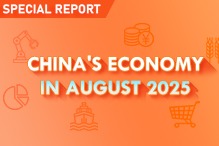Financial de-risking remains key focus in future


China's financial risks have been converging of late, but de-risking in the future will fundamentally depend on the stabilization and recovery of the economy.
As the economy further improves, there will be greater room for resolving financial risks in key areas, and such risks are expected to remain within control this year.
To start with, the country's small and medium-sized financial institutions have made positive progress in reforming and reducing risks. This is significant since they are a fragile part of the country's financial system.
Their risk indicators are showing steady improvement.
The nonperforming loan ratio of the country's commercial banks was 1.59 percent at the end of 2023, a decrease of 0.04 percentage point from the previous year. It has continued to trend downward since 2019.
The nonperforming loan ratio of rural commercial banks was 3.34 percent, an increase of 0.12 percentage point from the end of 2022. Although this has increased due to the relatively lower proportion of assets in the banking system, its impact on the overall risk of the industry is relatively limited.
The nonperforming loan balance of rural commercial banks at the end of 2023 was 862.3 billion yuan ($119 billion), accounting for about a quarter, of the total.
In recent years, China's financial institutions in the banking sector, including small and medium-sized lenders, have continued to increase their efforts to dispose of nonperforming assets, which is another effective means to resolve financial risks.
From 2020 to 2023, they disposed of nonperforming assets totaling 3.02 trillion yuan, 3.13 trillion yuan, 3.1 trillion yuan, and 3 trillion yuan, respectively.
The scale of such disposals has been high for several years and is roughly equivalent to the size of the balance of nonperforming loans.
Effective hedge
These efforts have effectively hedged the impact of external adverse factors such as the COVID-19 pandemic and macroeconomic downturn on small and medium-sized financial institutions, and helped keep their nonperforming loan ratio at a low level in general.
Since the beginning of this year, the capital replenishment of small and medium-sized banks has also maintained a relatively faster pace. Many banks have increased their registered capital through profit conversion, raising shares, and issuing secondary capital bonds.
At the end of 2023, the capital adequacy ratio of the country's commercial banks was 15.06 percent, and that of urban commercial banks and rural commercial banks was 12.63 percent and 12.22 percent, respectively. These three indicators all remain at a relatively high level.
From 2020 to 2022, small and medium-sized banks issued special bonds of 50.6 billion yuan, 159.4 billion yuan, and 63 billion yuan, respectively. In 2023, a total of 218.28 billion yuan of special bonds were issued to supplement the capital of small and medium-sized banks.
In addition, the restructuring and integration of small and medium-sized financial institutions are progressing in an orderly manner. Mergers and reorganizations have become one of the main ways for small and medium-sized banks to reform and reduce risks.
Since 2023, more than 10 rural banks have been approved for dissolution, and they were mainly absorbed and merged by large banks that have direct or indirect equity participation.
In June last year, Chinese authorities proposed to formulate and implement a package of debt reduction plans and expanded the scope of debt risk prevention and resolution from "local government debt" to "local debt".
With the implementation of a series of such policies, local debt has declined in terms of both the existing scale and issuance price, and the overall risks have been alleviated.
In terms of fiscal policy, local governments have restarted the issuance of special refinancing bonds to replace the existing implicit debts and repay government arrears to enterprises.
As of the end of 2023, at least 27 provincial-level regions have issued special refinancing bonds worth a total of 1.39 trillion yuan. A variety of measures had also been taken to resolve local debts.
In particular, with the implementation of a package of debt reduction plans, more urban investment bonds have been repaid since the fourth quarter, and this trend is expected to continue this year.
Against the backdrop of an overall downward trend in financing costs, the issuance interest rate of urban investment bonds has declined since December 2022.
This trend has been particularly evident since the implementation of a package of debt reduction plans. Such reductions play an important role in reducing the interest burden of urban investment companies.
Although the country's real estate market is still weak, its financial risks have improved to a certain extent, instead of worsening.
First, the country has increased policy support on both supply and demand sides. As of February, 276 cities across the country had established urban financing coordination mechanisms, and a total of 6,000 real estate projects had been proposed. The nation's commercial banks had quickly approved loans exceeding 200 billion yuan.
In terms of demand, various areas, as represented by first-tier cities such as Beijing, Shanghai, Guangzhou, and Shenzhen, have relaxed housing purchase restrictions.
Such efforts include relaxing the standards for ordinary residences, lowering the down payment ratio and a lower limit of mortgage interest rates, relaxing the conditions for home purchase and settlement, and increasing home purchase subsidies.
Second, it is expected that the number of defaulting entities and the scale of defaults on real estate corporate bonds will further decline.
With more bailout policies, many real estate companies that were in danger have recently accelerated their debt repayment and basically completed the restructuring or extension of domestic and overseas debts, thus avoiding risk contagion to the financial system.
Third, the real estate industry currently does not account for a high proportion of loan investments of financial institutions; thus, its overall risk impact on financial institutions is limited.
As of the end of 2023, the balance of loans of financial institutions was 237.59 trillion yuan. In comparison, the balances of real estate development loans, personal housing loans, and real estate loans were 12.88 trillion yuan, 38.17 trillion yuan, and 52.63 trillion yuan, respectively.
They accounted for 5.42 percent, 16.07 percent and 22.15 percent, respectively, of the total loan balances of financial institutions, all of which had decreased compared with that of 2022.
The writer is a researcher at the Institute of Finance and Banking of the Chinese Academy of Social Sciences.
The views don't necessarily reflect those of China Daily.




































